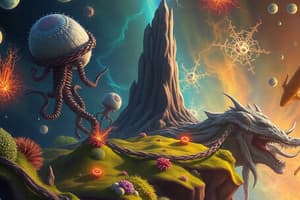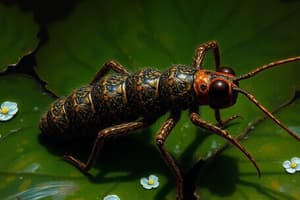Podcast
Questions and Answers
Which of the following is a characteristic shared by all animals?
Which of the following is a characteristic shared by all animals?
- They are multicellular. (correct)
- They are all pathogens.
- They are prokaryotes.
- They are autotrophs.
What is the name of the thread-like structures that make up the mycelium of a fungus?
What is the name of the thread-like structures that make up the mycelium of a fungus?
- Chloroplasts
- Nuclei
- Hyphae (correct)
- Chromosomes
Which of the following statements accurately describes a key difference between plants and fungi?
Which of the following statements accurately describes a key difference between plants and fungi?
- Plants are prokaryotes, while fungi are eukaryotes.
- Plants are heterotrophs, while fungi are autotrophs.
- Plants can photosynthesize, while fungi cannot. (correct)
- Plants are unicellular, while fungi are multicellular.
The term 'protist' refers to what group of organisms?
The term 'protist' refers to what group of organisms?
How do bacteria obtain energy?
How do bacteria obtain energy?
What is the primary difference between eukaryotic and prokaryotic cells?
What is the primary difference between eukaryotic and prokaryotic cells?
Which of the following is a characteristic that distinguishes viruses from the other five kingdoms of life?
Which of the following is a characteristic that distinguishes viruses from the other five kingdoms of life?
What is the function of the protein coat in a virus?
What is the function of the protein coat in a virus?
What is a saprotroph?
What is a saprotroph?
Which of the following is NOT a characteristic of animals?
Which of the following is NOT a characteristic of animals?
Which of the following is an example of a protist that can photosynthesize?
Which of the following is an example of a protist that can photosynthesize?
Why are viruses considered parasites?
Why are viruses considered parasites?
What is the main difference between prokaryotic and eukaryotic cells in terms of their DNA?
What is the main difference between prokaryotic and eukaryotic cells in terms of their DNA?
Which of the following statements is TRUE about viruses?
Which of the following statements is TRUE about viruses?
Which of the following kingdoms includes the largest estimated number of species?
Which of the following kingdoms includes the largest estimated number of species?
Flashcards
Five Kingdoms of Life
Five Kingdoms of Life
The main classification categories for living organisms: animals, plants, fungi, protists, and bacteria.
Eukaryotes
Eukaryotes
Organisms whose cells have a nucleus and chromosome DNA structure.
Prokaryotes
Prokaryotes
Organisms without a nucleus, their DNA is free-floating in the cell.
Multicellular
Multicellular
Signup and view all the flashcards
Heterotrophs
Heterotrophs
Signup and view all the flashcards
Autotrophs
Autotrophs
Signup and view all the flashcards
Fungi Characteristics
Fungi Characteristics
Signup and view all the flashcards
Mycelium
Mycelium
Signup and view all the flashcards
Saprotrophic Nutrition
Saprotrophic Nutrition
Signup and view all the flashcards
Protists
Protists
Signup and view all the flashcards
Bacteria
Bacteria
Signup and view all the flashcards
Viruses
Viruses
Signup and view all the flashcards
Pathogens
Pathogens
Signup and view all the flashcards
Examples of Viruses
Examples of Viruses
Signup and view all the flashcards
Study Notes
Living Organisms: Key Features and Differences
- Five Kingdoms of Life (excluding viruses): Animals, plants, fungi, protists, and bacteria.
- Eukaryotes (Animals, Plants, Fungi, Protists): Contain a nucleus where DNA is housed as chromosomes. Cells are more complex.
- Prokaryotes (Bacteria): DNA is free-floating in the cell; lacks a nucleus. Cells are structurally simpler.
- Viruses: Non-living particles that need to infect living cells to reproduce. Viruses are much smaller than prokaryotic cells.
- Multicellular vs. Unicellular Organisms: Multicellular organisms (animals and plants) have many cells combining to create the organism; unicellular organisms (some protists and bacteria) each cell is an entire organism..
Animal Kingdom
- Estimated 5-10 million species.
- Multicellular: Composed of numerous cells working together.
- Heterotrophic: Obtain energy by consuming other organisms.
- Mostly reproduce sexually.
- Examples: Humans, cattle, ladybirds, and lionfish.
- The estimated number of cells in an adult human is 40 trillion.
Plant Kingdom
- Estimated around 300,000 species.
- Multicellular.
- Autotrophic: Obtain energy from sunlight via photosynthesis.
- Examples: Redwood trees, orchids, tomatoes, and water lilies.
Fungi Kingdom
- Can be unicellular (e.g., yeast) or multicellular (e.g., mushrooms).
- Heterotrophic (but often also saprophytic - absorbing nutrients from dead organic matter).
- Secrete enzymes outside their body to digest food and then absorb the breakdown products.
- Mycelium: The body of multicellular fungi, consisting of hyphae.
- Hyphae: Thread-like structures forming the mycelium.
- Some fungi can be pathogens (e.g., causing athlete's foot).
Protist Kingdom
- Primarily unicellular.
- Exhibit diverse characteristics: Some are photosynthetic (e.g., chlorella, euglena), like plants, while others are predatory (e.g., amoeba), like animals.
- Some are pathogenic (e.g., Plasmodium causing malaria).
Bacteria Kingdom
- Unicellular prokaryotes.
- Found nearly everywhere (skin, intestines).
- Heterotrophic or photosynthetic.
- Estimated to have a larger diversity of species than all other kingdoms combined.
- Some are pathogens (e.g., Salmonella causing food poisoning).
- Many beneficial bacteria aid digestion.
Virus Kingdom
- Nonliving particles, not considered organisms.
- Extremely small (millions can fit on a fingernail).
- Protein coat surrounding genetic material (DNA or RNA).
- Reproduce only inside living cells.
- Always pathogenic.
- Examples: Influenza, tobacco mosaic virus, HIV, COVID-19.
Studying That Suits You
Use AI to generate personalized quizzes and flashcards to suit your learning preferences.




